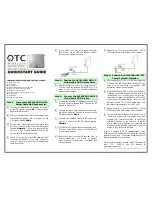
Deployment Guide
43
Defining a MAC OUI
1. Log in to the HiveManager GUI.
2. Click
HiveAP Configuration
>
Network Objects
>
MAC Address/OUI
> (Add button).
3. Enter the following, and then click
OK
:
•
MAC OUI: (
select
)
•
MAC Entry Name: Type a name such as "VoIP_Phones". You cannot include any spaces when defining a MAC
entry name.
•
MAC OUI: Type the OUI for the VoIP phones used in the network; that is, type the first six numbers
constituting the vendor prefix of the MAC address. For example, if a MAC address is 01:22:34:AB:6C:04, the
OUI is 01:22:34.
•
Comment: Type a meaningful comment for the MAC OUI, such as the vendor that the OUI identifies.
Mapping the MAC OUI and Services to Aerohive Classes
Map VoIP phone MAC OUIs to Aerohive class 6 so that you can give voice traffic higher priority than other types of
traffic. Because voice traffic is delay-sensitive, you need to make sure that the HiveAPs forward voice traffic
immediately. Other types of traffic, such as data traffic
—
and, to a lesser degree, streaming media
—
can better
tolerate delayed delivery without performance degradation.
Then you map DNS and DHCP services to Aerohive class 5 and TFTP and HTTP services to class 2. You have already
mapped voice traffic
—
the only remaining type of traffic from a VoIP phone
—
to class 6. Although all these services
are critical for IP telephony to function properly, voice traffic is the least resistant to delay, and TFTP and HTTP file
downloads are the most resistant. Therefore, you prioritize the different traffic types accordingly.
1. Click
HiveAP Configuration
>
QoS Classification and Marking
>
(Add button).
The New QoS Classification and Marking Policy dialog box appears.
2. Click the
Admin
tab, enter the following, and clear all other options
—
except #4 "Incoming Marked Packets" and
"802.11e Layer-2 (Wireless)/802.1p Layer-2 (Ethernet)" for the Access Interface, which cannot be cleared:
•
QoS Policy Name:
VoIP-QoS
(You cannot include any spaces when defining a QoS policy name.)
•
Comment: Add a descriptive comment, such as "Mapping for VoIP phone traffic "
•
Network Service: (
select
)
•
Access Interface: (
select
)
•
Backhaul Interface: (
select
)
•
MAC OUI: (
select
)
•
Access Interface: (
select
)
•
Backhaul Interface: (
select
)
3. Click the
MAC OUI
tab, right-click in the MAC OUI window, and choose
New
from the shortcut list that appears.
4. Enter the following, and then click
OK
:
•
MAC Vendor ID Name: Select the name of the MAC OUI that you defined in
"Defining a MAC OUI"
.
•
Action:
Permit
•
Map to Class:
6 - Voice
•
Comment: Enter a meaningful comment about the MAC OUI for future reference.
•
Logging: Select the check box to enable the logging of traffic classified to this class. Clear the check box to
disable logging.
Note:
If there are phones from more than one vendor, make a MAC OUI entry for each one.
















































